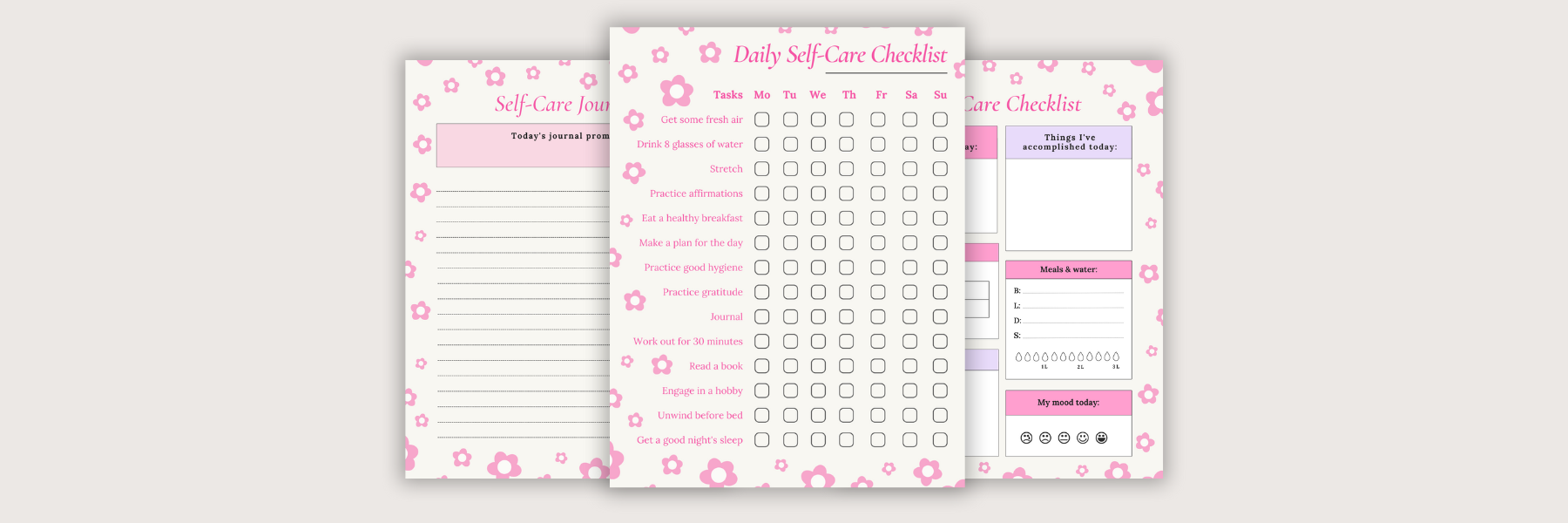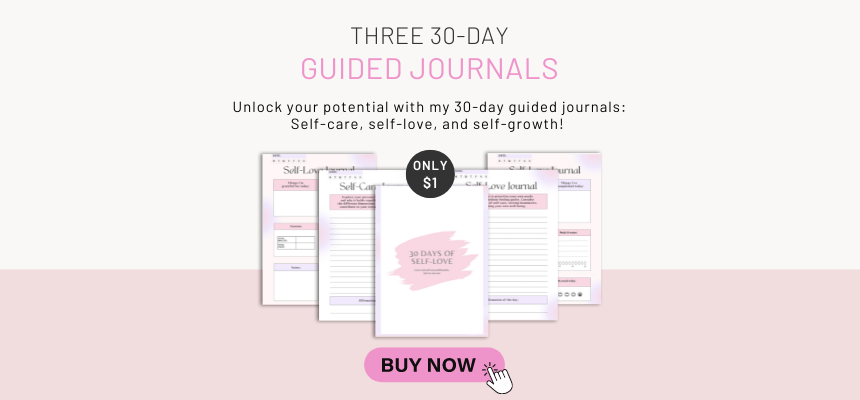Things to write in your personal boundaries journal
We’ll be talking about journal prompts for setting boundaries.
Are you ready to embark on a self-discovery and empowerment journey? Today, we’re exploring the wonderful world of setting boundaries with the help of journaling. Yes, you read that correctly!
Journaling is a great way to express yourself creatively while also cultivating self-awareness and maintaining healthy relationships.
So grab your favorite pen and a comfortable spot, because I’m about to reveal some incredible journal prompts for setting boundaries that will help you establish and reinforce your personal boundaries.

This post may contain affiliate links. That means that if you click on a link and purchase something I recommend, I will receive a small commission at no extra cost to you.
75 journal prompts for boundaries
15 journal prompts for emotional boundaries
- What are some healthy ways for expressing and processing my emotions?
- What emotions or situations drain my energy and make me feel overwhelmed?
- What are some warning signs or red flags that my emotional boundaries are being crossed?
- Is there anything in my past that has influenced my emotional boundaries? How can I recover and move on?
- How can I effectively communicate my emotional needs to others?
- What are my core values regarding emotional well-being? How can I respect them by setting boundaries?
- How do I build a network of people who respect and honor my emotional boundaries?
- How can I put my emotional well-being first without feeling guilty?
- What steps can I take to develop a better relationship with my emotions and emotional resilience?
- How can I set limits for sharing personal information or experiences with others?
- Are there any negative thought patterns or self-talk patterns that are interfering with my emotional boundaries? How can I get rid of them?
- Is there any particular relationship or environment that consistently tests my emotional boundaries? How should I approach them?
- What self-care practices or activities nourish and replenish my emotional well-being?
- What positive affirmations or mantras can I use to strengthen my emotional boundaries?
- When my emotional boundaries have been crossed, how can I practice self-compassion and forgiveness?
You might also like: These nighttime prompts will help you fall asleep in no time
15 boundary journal prompts for relationships
- Think about the value of open and honest communication in your relationships. How can you set boundaries that promote open communication and trust?
- Consider your social circle and the energy with which you surround yourself. How can you create a more positive and uplifting network by establishing boundaries around toxic or draining relationships?
- Reflect on how much time and energy you put into your relationships. Is there anything that needs to be corrected? How can you set limits to ensure mutuality?
- What are your personal boundaries in your relationships when it comes to privacy and personal space? What are the best ways to communicate and reinforce these boundaries with your loved ones?
- Consider a relationship in which your boundaries were repeatedly violated. How can you assertively communicate your boundaries and advocate for your needs?
- What are your non-negotiable values and boundaries in friendships, family relationships, and romantic relationships? How will you convey these to others?
- Consider the balance between independence and interdependence in your relationships. How can you set boundaries that respect your uniqueness while also fostering healthy connections?
- Think about an emotionally draining relationship in your life. What specific boundaries can you establish in this relationship to protect your emotional well-being?
- Consider your relationship expectations. Are they reasonable and healthy? How can you set expectations for boundaries to avoid disappointment or resentment?
- Are there any past relationships or patterns that have caused you to disregard your own boundaries? How can you learn from them and set healthier boundaries in the future?
- Consider any codependent tendencies or patterns in your relationships. How can you establish boundaries that encourage independence, self-sufficiency, and healthy interdependence?
- Are there any relationships in your life where you overstep or disregard others’ boundaries? How can you train yourself to be more aware of and respectful of their boundaries?
- Determine whether any toxic or unhealthy dynamics exist in your relationships. What boundaries can you set and enforce to protect yourself from these negative influences?
- Are there any particular triggers or sensitive topics that frequently cause conflict in your relationships? How can you set limits for discussing and navigating these issues?
- Consider your own ability to provide support and help in your relationships. How can you set boundaries to avoid burnout and promote self-care while still being present for your loved ones?
You might also like: You will LOVE this 21-day journaling challenge for beginners

15 financial boundary journal prompts
- Consider your budgeting and expense-tracking boundaries. How can you establish routines and boundaries to ensure that your finances are consistently managed and monitored?
- Think about your limits in terms of impulse purchases. How can you set boundaries to avoid impulsive spending and ensure that your purchases are in line with your values and needs?
- Consider your personal lending and borrowing limits. How can you establish guidelines for determining when it is appropriate to borrow money and ensure responsible repayment?
- Consider your financial self-care boundaries. How can you set limits to avoid overspending on self-indulgences and maintain a healthy balance between treating yourself and saving for the future?
- Reflect on your credit card usage restrictions. How can you establish responsible credit card practices and set limits to avoid excessive debt and promote financial well-being?
- Consider your financial limits when it comes to lending money to others. How can you create guidelines for deciding when and how to provide financial help to friends or family members?
- Reflect on your financial boundaries in relation to others. How can you cultivate a healthy mindset while avoiding undue financial pressure to keep up with others?
- Consider your financial transparency and communication boundaries in relationships. How can you have open and honest conversations about money with your partners or family members to foster trust and alignment?
- Consider your financial independence boundaries. How can you set boundaries to maintain control over your financial decisions while avoiding unnecessary influence from others?
- Think about your current financial situation and goals. What are your financial priorities, and how can you set boundaries to align your spending and saving habits with those priorities?
- Consider your personal financial obligations, such as bills and loans. How can you set up systems and reminders to ensure that you meet your financial obligations on time?
- Reflect on your overall financial priorities and values. How can you set boundaries that reflect these values in order to lay a solid foundation for your financial well-being?
- Consider your financial emergency boundaries. How can you create an emergency fund and set up rules for accessing it to protect yourself from unexpected financial hardships?
- Think about your savings and investment limits. How can you establish specific goals and boundaries to save and grow your financial resources for the future?
- Consider your charitable giving and donation boundaries. How can you create guidelines to ensure that your contributions are consistent with your values and financial capacity?
15 journal prompts for setting boundaries around time
- Think about your peak productivity times. How can you set boundaries to protect and prioritize your most important and focused work?
- Consider your current work habits and routines. Is there anything you tend to overwork or struggle to disconnect from? How can you set boundaries to encourage a more balanced approach to your time and work?
- Consider your boundaries in terms of setting realistic deadlines and effectively managing your workload. How can you set boundaries in order to avoid taking on more than you can handle while maintaining a healthy work pace?
- Think about your current relationship with time. How do you perceive and value time? How can you set boundaries in order to effectively prioritize your time?
- Consider your boundaries regarding working outside of designated working hours. How can you set boundaries to protect your personal time and keep work from invading other areas of your life?
- Reflect on your limits in terms of interruptions and distractions. What strategies can you use to reduce interruptions and maintain a focused work environment?
- Consider your availability and responsiveness to work-related communication (emails, phone calls, and messages). How can you set boundaries to establish designated response times while avoiding being available all the time?
- Reflect on your overall goals and priorities. How can you set boundaries that are consistent with your values and allow you to devote your time and energy to the things that truly matter?
- Consider your work-related stress levels. How can you establish boundaries in order to prioritize self-care and avoid burnout? What activities or practices can you include in your daily routine to help you recharge and relax?
- Consider your limits in terms of multitasking and overcommitting. How can you set boundaries to avoid spreading yourself too thin and ensure you have enough time to devote to each task or responsibility?
- Think about your work-related meetings and commitment boundaries. How can you create guidelines to ensure that meetings are productive, purposeful, and respectful of your time?
- Consider your boundaries around breaks and time off. How can you make certain that you take regular breaks and vacation time to recharge and rejuvenate?
- Think about your ideal work-life balance. What boundaries can you set to ensure that you have time for work, rest, relaxation, and personal activities?
- Consider your limits for saying “no” to new tasks or projects. How can you set boundaries in order to avoid overburdening yourself and maintain a healthy work-life balance?
- Consider your personal boundaries in relation to work-related expectations from others. To manage expectations and avoid feeling overwhelmed, how can you establish clear communication and realistic boundaries?
You might also like: Try these new year prompts to truly reflect on the past year

15 journal prompts for physical boundaries
- Consider any previous incidents in which your physical boundaries were crossed or violated. How can you use those experiences to strengthen your boundaries in the future?
- Think about your physical touch boundaries during times of stress or emotional distress. How do you express your desire for personal space or comfort without feeling guilty?
- Reflect on your level of comfort with physical activities or sports. What are your limits when it comes to physical play or contact with others? How do you communicate while maintaining these boundaries?
- Consider your personal space boundaries at home or in shared environments. How can you communicate and maintain boundaries so that you have the space you need to feel safe and comfortable?
- Think about your personal space preferences. How much physical separation do you prefer between yourself and others? How are you going to communicate and enforce this boundary?
- Consider your digital boundaries in relation to your physical boundaries (e.g., online interactions, social media). How do you set and keep boundaries to protect your privacy and well-being?
- Consider your tolerance for physical contact from others. What types of touch are you comfortable with, and where do you draw the line? How can you express and maintain your boundaries assertively?
- Reflect on your limits in terms of physical labor or tasks. How can you set boundaries to avoid overworking or feeling taken advantage of by others?
- Consider your physical intimacy boundaries in romantic relationships. What are your limits and desires? How can you express and respect these boundaries within your relationship?
- Reflect on your comfort level with unexpected or surprising physical contact. How can you establish boundaries to protect your personal space and ensure that your consent is respected?
- Think about your level of comfort with sharing personal belongings. Are there any particular items you prefer to keep private? How can you set boundaries to protect your belongings and ensure they are treated respectfully?
- Consider your personal boundaries when it comes to physical activities or hobbies. How can you set boundaries and communicate them to others who may be involved in those activities?
- Reflect on your physical health and well-being boundaries. How can you develop self-care practices and boundaries that put your physical needs first?
- Consider your boundaries when it comes to physical affection in public. How do you handle displays of affection, such as holding hands or kissing, in various situations? How can you set boundaries that are compatible with your level of comfort?
- Think about your boundaries around physical appearance and personal grooming. How do you establish and communicate your expectations regarding personal hygiene and cleanliness?
You might also like: These growth mindset prompts will transform your life


FAQ: What exactly are healthy boundaries?
Setting boundaries has been a life-changing journey of self-discovery and empowerment for me.
It’s about recognizing my own needs, honoring my values, and effectively communicating them to the people in my life.
I used to be a people-pleaser, always putting other people’s needs ahead of my own, until I realized I was ignoring my own happiness and self-care.
So, exactly what are healthy boundaries? They’re like little arrows pointing you in the direction of a life of balance and fulfillment. They teach you to say “yes” to yourself and “no” when necessary.
It could be setting aside quiet time in the mornings to practice self-care rituals or asserting your personal space when you need a moment to yourself.
Let me give you an example from my own life. I have a friend who constantly oversteps boundaries by asking for favors, frequently putting me in awkward situations.
I’ve been able to identify my limits and gain the courage to communicate them through journaling.
I keep a journal about what specific actions make me uncomfortable and experiment with different ways to respond assertively yet kindly.
I’ve not only strengthened our friendship but also reclaimed my own sense of self-worth by establishing boundaries.
Building walls or shutting people out are not examples of healthy boundaries. Healthy boundaries are about establishing a foundation of self-esteem and fostering healthier relationships.
They give you the ability to take care of yourself and be your best self in all aspects of life.
You might also like: Follow these rules for a happier life (setting boundaries is there)

FAQ: Why do boundaries matter?
Boundaries are important first and foremost because they honor your self-worth and self-care.
When you set and maintain healthy boundaries, you send a strong message to yourself and others that your well-being is important.
It’s the equivalent of saying, “I value myself enough to set limits that protect my physical, emotional, and mental health.”
Boundaries have personally helped me develop a greater sense of inner peace and balance. They’ve given me the freedom to devote time to activities that bring me joy and recharge my spirit.
Setting time boundaries allows me to make time for self-care rituals, hobbies, and quality time with loved ones.
It’s amazing how simple boundary-setting can lead to a more fulfilling and enriching life. Boundaries are also important in fostering healthy relationships.
You give others the opportunity to understand and respect your needs when you communicate your boundaries clearly and respectfully.
This allows for deeper connection and mutual understanding.
It’s amazing how boundaries can actually improve relationships by encouraging honesty, trust, and a genuine concern for one another.
Also, boundaries allow you to develop a strong sense of self. They allow you to identify your values, desires, and limits, all of which are essential components of who you are.
You stand tall in your authenticity and create a life that aligns with your true self by respecting and honoring your boundaries.

FAQ: How do I set boundaries in relationships with other people?
Start with self-reflection
Take the time to learn about your own needs, values, and limitations. Consider what makes you feel at ease or uneasy in various situations.
This self-awareness serves as the foundation for effective boundary-setting.
Communicate openly and truthfully
Once you’ve established your boundaries, it’s critical to communicate them openly and honestly with the people in your life.
When expressing your needs, desires, or limits, be respectful but assertive. Remember that effective communication is essential.
Be specific and clear
When establishing boundaries, it’s important to be specific and clear about what you are and aren’t comfortable with.
Uncertain boundaries can cause confusion and misunderstandings. Use concrete examples and express your boundaries in a way that leaves little room for misunderstanding.
Trust your instincts
When it comes to setting boundaries, trust yourself and your intuition. Listen to your inner voice if something feels off or uncomfortable.
Your feelings are valid, and honoring them is critical to your well-being.
Practice self-compassion
Setting boundaries may feel awkward at first, especially if you’re used to putting others’ needs ahead of your own.
Throughout this process, remember to be kind and compassionate to yourself. It’s acceptable to prioritize your well-being and establish boundaries that are in your best interests.
Be prepared for a range of reactions
Understand that your boundaries may not be well received by everyone. Some people may object, challenge, or even ignore them.
Maintain your convictions, and remember that your boundaries aren’t negotiable.
When necessary, impose consequences
When someone consistently disregards or violates your boundaries, it’s important to impose consequences.
You can limit contact, reevaluate the relationship, or seek help from trusted friends or professionals.
Seek help if necessary
If you’re having trouble establishing or maintaining boundaries, don’t be afraid to seek help from trusted friends, family, or even therapists.
They can provide guidance, validation, and encouragement as you travel this path.
You might also like: Start romanticizing your life today and set boundaries

FAQ: What is journaling?
So, picture this: You, a cozy corner, and a nice pink life and goal planner that’s just waiting to be filled with your thoughts, dreams, and everything in between. That’s what journaling is all about!
Journaling is similar to having an in-depth conversation with yourself, but on paper. It’s your personal space to let your thoughts, feelings, and experiences flow freely.
Think of it as your secret haven where you can be completely, unapologetically YOU.
Now, journaling isn’t just about writing a boring diary entry as you did in middle school (though if that’s your thing, go ahead and do it!).
It’s about going deep, exploring your inner world, and learning amazing things about yourself.
Imagine sitting down with your journal and pen and pouring out your heart. Maybe you’re scribbling down the highlights of your day, or maybe you’re working through a difficult situation.
It’s like having a reliable sidekick who is always willing to listen and lend a shoulder to cry on.
But journaling isn’t just for venting or ranting (though we all need that now and then, don’t we?). It’s a powerful tool for personal development and self-discovery.
By writing down your thoughts, you gain clarity, untangle your emotions, and uncover the hidden gems of wisdom that have been hiding within you all along.

FAQ: What are the benefits of journaling?
Journaling is like a superhero cape for your mind and soul. Are you ready to discover the superpowers it brings?
Stress-busting magic
Are you feeling overwhelmed? Pour it all out onto those pages! Journaling is an excellent stress reliever.
It allows you to release the weight of the world from your shoulders and gain clarity and calm.
Self-discovery extravaganza
Journaling is your personal map to self-discovery. It’s an opportunity to delve deep and reveal those hidden layers of your fabulous self.
You’ll gain insights, notice patterns, and gain a better understanding of what makes you tick. Talk about bringing out your inner superhero!
Emotional liberation
Do you know those emotions that feel like a roller coaster ride? Journaling (especially with the help of journal prompts for setting boundaries) gives you a front-row seat to life!
Writing down your emotions can be like releasing them, releasing the pressure valve, and finding that sweet relief. Happy tears, sad tears—they’re all welcome!
Goal-setting galore
Journaling isn’t just about venting; it’s also a powerful tool for setting and achieving goals.
Make a list of your goals, create a plan of action, and watch as you transform into a goal-crushing dynamo!
A memory treasure chest
Life moves at lightning speed, but with journaling, you can capture those precious moments and memories.
Jot down the highlights, milestones, and hilarious anecdotes. It’s like creating a time capsule of your fabulous life.
Problem-solving ability
Stuck in a pickle? Journaling to the rescue! Writing about challenges and dilemmas helps you see things from different angles, gain fresh perspectives, and come up with creative solutions.
Say goodbye to those annoying problems!
Self-care sanctuary
Journaling is an act of self-love and self-care. It’s a sacred ritual that allows you to prioritize your own well-being.
Set aside time just for you, create a cozy atmosphere, and let your pen dance across the pages. You deserve this nurturing escape!
You might also like: Learn to finally say no without explaining yourself

FAQ: How can journaling help me set boundaries?
Clarity
Boundaries journaling allows you to untangle the thoughts racing through your head and gain crystal-clear clarity on the boundaries you need to establish.
Take a moment to reflect on your experiences, jot down your thoughts, and identify situations where you felt uncomfortable or overwhelmed.
Trust me when I say that the words on the page will lead you to the boundaries you seek.
Expressive exploration
Grab a pen and let your emotions run wild on the pages of your journal. Journaling allows you to express yourself in a safe environment.
Investigate your desires, fears, and limitations. Be honest with yourself. As you go deeper, you’ll get a better sense of what boundaries are necessary for your well-being.
Setting intentions
By using journaling prompts for setting boundaries, you can set intentions for the boundaries you want to establish.
Write them down as affirmations, self-love declarations, or even mini-manifestos.
Declare to yourself and the universe that you’re capable of maintaining healthy boundaries. Put it in writing, and it will come to life!
Boundary brainstorming
Make use of your journal as a resource for boundary-setting strategies. Allow your imagination to run wild and jot down ideas for effective boundary communication.
Consider how you would handle any potential challenges or objections. Your journal has transformed into your personal boundary-setting workshop.
Reinforcement and reflection
Keep a journal as you work through the process of establishing boundaries. Consider your progress, celebrate your victories, and learn from any setbacks.
When you need a little boost to reinforce those boundaries, use your journal as a source of strength and inspiration.
Self-compassion zone
Journaling is a safe haven for self-compassion. Be gentle with yourself if you encounter resistance or find it difficult to set and maintain boundaries.
Write self-affirmations, remind yourself of your worth, and acknowledge your accomplishments. Journaling becomes your self-care buddy, offering encouragement and support along the way.
Did you find any good journal prompts for setting boundaries?
How do you set boundaries? I would love to hear your thoughts.

I’m a personal growth and self-care expert, as well as an avid motorcycle enthusiast and coffee and sweets lover. Through Lauraconteuse, I provide insightful and practical advice on topics such as self-care, self-love, personal growth, and productivity, drawing from my very own extensive experience and knowledge in the field. My blog has helped countless people achieve their goals and live more fulfilling lives, and my goal is to continue to inspire and empower others.








